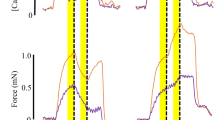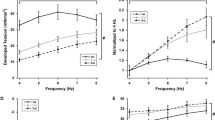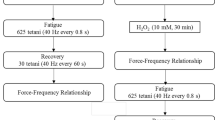Abstract
The effect of zinc ions on the isometric contraction of rat diaphragm muscles in the presence and in the absence of external calcium was studied. Using a transducer, the isometric force was measured as a function of supramaximal electrical stimulation, either directly or indirectly applied to the muscle. The following parameters were measured: peak twitch tension, PT, twitch contraction time, CT, relaxation half-time, RT-1/2, and peak rates of tension increase and decrease, +dP/dt and -dP/dt. The following zinc-induced alterations were observed: an increase of the PT; a decrease of the RT-1/2; an increase in the +dP/dt and -dP/dt. The CT was not changed significantly. Our results suggest that zinc ions have a positive inotropic effect on isolated diaphragm muscle. The increase in PT may be explained by a zinc-activated Ca2+ uptake by sarcoplasmic reticulum. This was followed by an increase in the rate of rise of tension development, which was secondary to increased -dP/dt. The mechanism(s) by which extracellular Ca2+ contributes to this action of zinc is not known.
Similar content being viewed by others
References
A. S. Prasad, Clinical, endocrinological and biochemical effects of zinc deficiency.Clin. Endocrinol. Med. 14, 567–589 (1985).
B. L. Valle and K. A. Falchuk, The biochemical basis of zinc physiology.Physiol. Rev. 73, 79–118 (1993).
S. S. Hede, R. S. Diniz, N. V. Agshikar, and V. G. Dhume, Dual action of zinc on ileal smooth muscle. Zinc-calcium interaction.Ind. J. Physiol. Pharmacol. 30, 321–328 (1986).
E. E. Daniel, R. Massingham, and P. A. Nasmyth, The mechanism of contractile effects of ouabain and zinc on the rat uterus.J. Pharmacol. Exp. Ther. 173, 293–307 (1970).
E. E. Daniel, S. Fair, A. M. Kidwas, and I. Polacek, Zinc and smooth muscle contractility. I. Study of the mechanisms of zinc-induced contractility changes in rat uteri.J. Pharmacol. Exp. Ther. 178, 282–289 (1971).
C. Cho II, and G. W. Teh, The inhibitory action of zinc sulphate on the contractile activity of guinea-pig ileum.43, 294–296 (1991).
J. Cortijo, J. V. Espluques, B. Sarria, M. Marti-Cabrera, and J. Esplugues, Zinc as a calcium antagonist: A pharmacological approach in the strips of rat aorta.IRCS Med Sci. 13, 292, 293 (1985).
B. Sarria, J. Cartigo, M. Marti-Cabrera, E. Morcillo, and J. Esplugues, Antagonism of Ca2+ by zinc in guinea-pig isolated taena caeci and trachealis muscle.Br. J. Pharmacol. 97, 19–26 (1989).
A. Sandow, S. R. Taylor, and H. Preuer, Role of the action potential in excitation-contraction coupling.Fed. Proc. Fed. Am. Soc. Exp. Biol. 24, 1116–1123 (1965).
S. R. Taylor, Vertebrate striated muscle: length-dependence of Calcium release during contraction.Eur. J. Cardiol. 4, 31–38 (1976).
S. R. Taylor, J. R. Lopez, P. J. Griffiths, G. Trube, and G. Cecehi, Calcium in excitation-contraction coupling of frog skeletal muscle.Can. J. Physiol. Pharmacol. 60, 489–502 (1982).
A. Isaacson and W. Sando, Effects of zinc on responses of skeletal muscle.J. Gen. Physiol. 46, 655–677 (1963).
F. R. Ciafalo and L. J. Thomas, The effects of zinc on contractility, membran potentials and cathion content of rat atria.J. Gen. Physiol. 48, 825–839 (1965).
W. G. Nayler and J. E. Anderson, Effect of zinc on cardiac muscle contraction.Am. J. Physiol. 209, 17–21 (1965).
M. Aubier, N. Viires, J. Piquet, D. Murciano, F. Planchet, C. Marty, R. Cherardi, and R. Pariente, Effects of hypocalcemia on diaphragmatic strength generation.J. Appl. Physiol. 58, 2054–2061 (1985).
A. Gölgeli, A. CoŞkun, and Ç. özesmi, Rat diaphragm muscle contraction with and without oxygen enrichment.Res. Commun. Mol. Pathol. Pharmacol. 90, 87–95 (1995).
A. Gölgeli, Ç. özesmi, and M. özesmi, Dependence of fatigue properties on the pattern of stimulation in the rat diaphragm muscle.Indian J. Physiol. Pharmacol. 39, 315–322 (1995).
A. Gölgeli, Ç. özesmi, and C. Süer, Effect of acute starvation on rat diaphragm function.Jpn. J. Physiol.,44, 743–747 (1994).
N. Viires, D. Murciano, J. P. Seta, B. Dureuil, R. Parienta, and M. Aubier, Effects of calcium withdrawal on diaphragmatic fiber tension generation.J. Appl. Physiol. 64, 26–30 (1988).
Canadian Council on Animal Care. Guide to the Care and Use of Experimental Animals. Ottawa, vol. 2 pp. 440–447 (1984).
S. G. Kelsen and M. L. Nochomowitz, Fatigue of the mammalian diaphragm in vitro.J. Appl. Physiol. 53, 440–447 (1982).
T. Oba, J. Takagi, and K. Hatta, Effect of temperature and zinc on isometric contractile properties and electrical phenomena of frog (Rana) and xenopus skeletal muscle fibers.Can. J. Physiol. Pharmacol. 62, 1511–1517 (1984).
J. P. Bianchi and S. Narayan, Effect of diazepam on Ca2+ translocation during physiological muscle fatique.J. Pharmacol Exp. Ther. 231, 197–205 (1984).
G. B. Frank, Rapid loss of the twitch of frog’s skeletal muscle fibers in 0-calcium bicarbonate-buffered ringer solution.Life Sci,22, 1077–1082 (1978).
G. B. Frank, Roles of extracellular and “trigger” calciumions in excitation-contraction coupling in skeletal muscle.Can. J. Physiol. Pharmacol. 60, 427–439 (1982).
S. A. Esau, Interaction of theophylline, verapamil and diltiazem on hamster diaphragm muscle force in vitro.Am. J. Physiol. 254, 365–371 (1988).
J. R. Blinks, R. Rudel, and S. R. Taylor, Calcium transients in isolated amphibian skeletal muscle fibers: Detection with acquonin.J. Physiol. (Lond.) 277, 291–323 (1987).
M. Endo, Calcium release from the sarcoplasmic reticulum.Physiol. Rev. 57, 71–108 (1977).
P. R. Standfield, The effect of zinc on the gating of the delayed potassium conductance of frog sartorius muscle.J. Physiol. (Lond.) 251, 711–735 (1975).
J. R. Lopez, L. A. Wanek, and S. R. Taylor, Skeletal muscle: length dependent effects of potentiating agents.Science (Washington, DC) 214, 79–82 (1981).
S. Howell, R. S. Fitzgerald, and C. H. Roussus, Effects of aminophylline, izoproteranol and neostigmine on hypercapnic depression of diaphragmatic contractility.Am. Rev. Respir. Dis. 132, 241–247 (1985).
Author information
Authors and Affiliations
Rights and permissions
About this article
Cite this article
Gölgeli, A., Dursun, N., Süer, C. et al. Zinc-induced alterations in contractile properties of rat diaphragm muscle in vitro. Biol Trace Elem Res 60, 251–260 (1997). https://doi.org/10.1007/BF02784445
Received:
Revised:
Accepted:
Issue Date:
DOI: https://doi.org/10.1007/BF02784445




